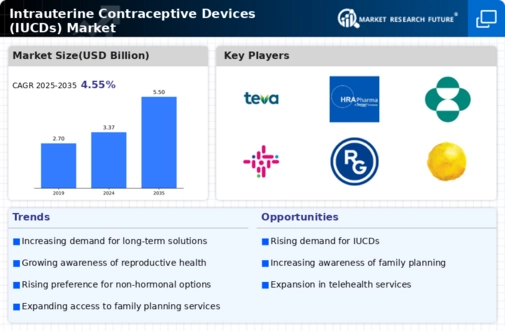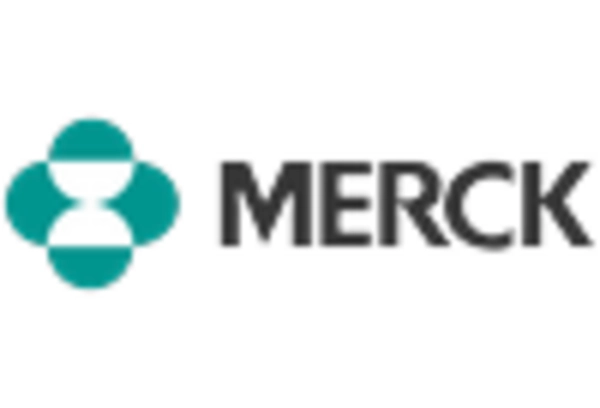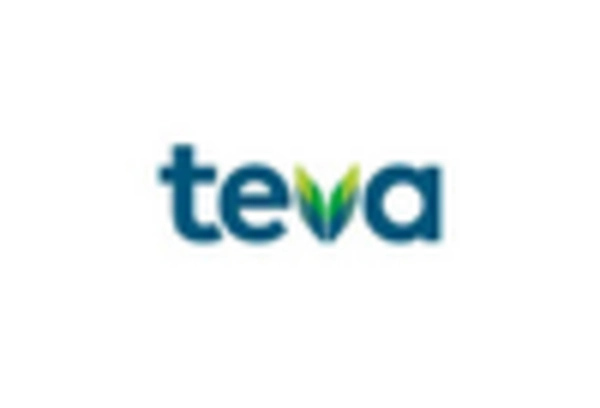-
EXECUTIVE SUMMARY
-
Market Overview
-
Key Findings
-
Market Segmentation
-
Competitive Landscape
-
Challenges and Opportunities
-
Future Outlook
-
MARKET INTRODUCTION
-
Definition
-
Scope of the study
- Research Objective
- Assumption
- Limitations
-
RESEARCH METHODOLOGY
-
Overview
-
Data Mining
-
Secondary Research
-
Primary Research
- Primary Interviews and Information Gathering Process
- Breakdown of Primary Respondents
-
Forecasting Model
-
Market Size Estimation
- Bottom-Up Approach
- Top-Down Approach
-
Data Triangulation
-
Validation
-
MARKET DYNAMICS
-
Overview
-
Drivers
-
Restraints
-
Opportunities
-
MARKET FACTOR ANALYSIS
-
Value chain Analysis
-
Porter's Five Forces Analysis
- Bargaining Power of Suppliers
- Bargaining Power of Buyers
- Threat of New Entrants
- Threat of Substitutes
- Intensity of Rivalry
-
COVID-19 Impact Analysis
- Market Impact Analysis
- Regional Impact
- Opportunity and Threat Analysis
-
INTRAUTERINE CONTRACEPTIVE DEVICES (IUCDS) MARKET, BY TYPE (USD BILLION)
-
Copper Intrauterine Devices
-
Hormonal Intrauterine Devices
-
Multi-Load Intrauterine Devices
-
INTRAUTERINE CONTRACEPTIVE DEVICES (IUCDS) MARKET, BY MATERIAL (USD BILLION)
-
Copper
-
Plastic
-
Hormonal
-
INTRAUTERINE CONTRACEPTIVE DEVICES (IUCDS) MARKET, BY DISTRIBUTION CHANNEL (USD BILLION)
-
Hospitals
-
Gynecology Clinics
-
Pharmacies
-
INTRAUTERINE CONTRACEPTIVE DEVICES (IUCDS) MARKET, BY END USER (USD BILLION)
-
Women of Reproductive Age
-
Healthcare Providers
-
Family Planning Organizations
-
INTRAUTERINE CONTRACEPTIVE DEVICES (IUCDS) MARKET, BY REGIONAL (USD BILLION)
-
North America
- US
- Canada
-
Europe
- Germany
- UK
- France
- Russia
- Italy
- Spain
- Rest of Europe
-
APAC
- China
- India
- Japan
- South Korea
- Malaysia
- Thailand
- Indonesia
- Rest of APAC
-
South America
- Brazil
- Mexico
- Argentina
- Rest of South America
-
MEA
- GCC Countries
- South Africa
- Rest of MEA
-
COMPETITIVE LANDSCAPE
-
Overview
-
Competitive Analysis
-
Market share Analysis
-
Major Growth Strategy in the Intrauterine Contraceptive Devices (IUCDs) Market
-
Competitive Benchmarking
-
Leading Players in Terms of Number of Developments in the Intrauterine Contraceptive Devices (IUCDs) Market
-
Key developments and growth strategies
- New Product Launch/Service Deployment
- Merger & Acquisitions
- Joint Ventures
-
Major Players Financial Matrix
- Sales and Operating Income
- Major Players R&D Expenditure. 2023
-
COMPANY PROFILES
-
LifeWave
- Financial Overview
- Products Offered
- Key Developments
- SWOT Analysis
- Key Strategies
-
Femedica
- Financial Overview
- Products Offered
- Key Developments
- SWOT Analysis
- Key Strategies
-
Bayer AG
- Financial Overview
- Products Offered
- Key Developments
- SWOT Analysis
- Key Strategies
-
Teva Pharmaceutical Industries
- Financial Overview
- Products Offered
- Key Developments
- SWOT Analysis
- Key Strategies
-
HRA Pharma
- Financial Overview
- Products Offered
- Key Developments
- SWOT Analysis
- Key Strategies
-
Mylan N.V.
- Financial Overview
- Products Offered
- Key Developments
- SWOT Analysis
- Key Strategies
-
Smith & Nephew
- Financial Overview
- Products Offered
- Key Developments
- SWOT Analysis
- Key Strategies
-
Ocon Medical Ltd
- Financial Overview
- Products Offered
- Key Developments
- SWOT Analysis
- Key Strategies
-
Merck & Co
- Financial Overview
- Products Offered
- Key Developments
- SWOT Analysis
- Key Strategies
-
Organon
- Financial Overview
- Products Offered
- Key Developments
- SWOT Analysis
- Key Strategies
-
Gedeon Richter
- Financial Overview
- Products Offered
- Key Developments
- SWOT Analysis
- Key Strategies
-
CooperSurgical
- Financial Overview
- Products Offered
- Key Developments
- SWOT Analysis
- Key Strategies
-
Hologic Inc
- Financial Overview
- Products Offered
- Key Developments
- SWOT Analysis
- Key Strategies
-
Zhejiang Medicine Co Ltd
- Financial Overview
- Products Offered
- Key Developments
- SWOT Analysis
- Key Strategies
-
Abbott Laboratories
- Financial Overview
- Products Offered
- Key Developments
- SWOT Analysis
- Key Strategies
-
APPENDIX
-
References
-
Related Reports
-
LIST OF TABLES
-
LIST OF ASSUMPTIONS
-
NORTH AMERICA INTRAUTERINE CONTRACEPTIVE DEVICES (IUCDS) MARKET SIZE ESTIMATES & FORECAST, BY TYPE, 2019-2035 (USD BILLIONS)
-
NORTH AMERICA INTRAUTERINE CONTRACEPTIVE DEVICES (IUCDS) MARKET SIZE ESTIMATES & FORECAST, BY MATERIAL, 2019-2035 (USD BILLIONS)
-
NORTH AMERICA INTRAUTERINE CONTRACEPTIVE DEVICES (IUCDS) MARKET SIZE ESTIMATES & FORECAST, BY DISTRIBUTION CHANNEL, 2019-2035 (USD BILLIONS)
-
NORTH AMERICA INTRAUTERINE CONTRACEPTIVE DEVICES (IUCDS) MARKET SIZE ESTIMATES & FORECAST, BY END USER, 2019-2035 (USD BILLIONS)
-
NORTH AMERICA INTRAUTERINE CONTRACEPTIVE DEVICES (IUCDS) MARKET SIZE ESTIMATES & FORECAST, BY REGIONAL, 2019-2035 (USD BILLIONS)
-
US INTRAUTERINE CONTRACEPTIVE DEVICES (IUCDS) MARKET SIZE ESTIMATES & FORECAST, BY TYPE, 2019-2035 (USD BILLIONS)
-
US INTRAUTERINE CONTRACEPTIVE DEVICES (IUCDS) MARKET SIZE ESTIMATES & FORECAST, BY MATERIAL, 2019-2035 (USD BILLIONS)
-
US INTRAUTERINE CONTRACEPTIVE DEVICES (IUCDS) MARKET SIZE ESTIMATES & FORECAST, BY DISTRIBUTION CHANNEL, 2019-2035 (USD BILLIONS)
-
US INTRAUTERINE CONTRACEPTIVE DEVICES (IUCDS) MARKET SIZE ESTIMATES & FORECAST, BY END USER, 2019-2035 (USD BILLIONS)
-
US INTRAUTERINE CONTRACEPTIVE DEVICES (IUCDS) MARKET SIZE ESTIMATES & FORECAST, BY REGIONAL, 2019-2035 (USD BILLIONS)
-
CANADA INTRAUTERINE CONTRACEPTIVE DEVICES (IUCDS) MARKET SIZE ESTIMATES & FORECAST, BY TYPE, 2019-2035 (USD BILLIONS)
-
CANADA INTRAUTERINE CONTRACEPTIVE DEVICES (IUCDS) MARKET SIZE ESTIMATES & FORECAST, BY MATERIAL, 2019-2035 (USD BILLIONS)
-
CANADA INTRAUTERINE CONTRACEPTIVE DEVICES (IUCDS) MARKET SIZE ESTIMATES & FORECAST, BY DISTRIBUTION CHANNEL, 2019-2035 (USD BILLIONS)
-
CANADA INTRAUTERINE CONTRACEPTIVE DEVICES (IUCDS) MARKET SIZE ESTIMATES & FORECAST, BY END USER, 2019-2035 (USD BILLIONS)
-
CANADA INTRAUTERINE CONTRACEPTIVE DEVICES (IUCDS) MARKET SIZE ESTIMATES & FORECAST, BY REGIONAL, 2019-2035 (USD BILLIONS)
-
EUROPE INTRAUTERINE CONTRACEPTIVE DEVICES (IUCDS) MARKET SIZE ESTIMATES & FORECAST, BY TYPE, 2019-2035 (USD BILLIONS)
-
EUROPE INTRAUTERINE CONTRACEPTIVE DEVICES (IUCDS) MARKET SIZE ESTIMATES & FORECAST, BY MATERIAL, 2019-2035 (USD BILLIONS)
-
EUROPE INTRAUTERINE CONTRACEPTIVE DEVICES (IUCDS) MARKET SIZE ESTIMATES & FORECAST, BY DISTRIBUTION CHANNEL, 2019-2035 (USD BILLIONS)
-
EUROPE INTRAUTERINE CONTRACEPTIVE DEVICES (IUCDS) MARKET SIZE ESTIMATES & FORECAST, BY END USER, 2019-2035 (USD BILLIONS)
-
EUROPE INTRAUTERINE CONTRACEPTIVE DEVICES (IUCDS) MARKET SIZE ESTIMATES & FORECAST, BY REGIONAL, 2019-2035 (USD BILLIONS)
-
GERMANY INTRAUTERINE CONTRACEPTIVE DEVICES (IUCDS) MARKET SIZE ESTIMATES & FORECAST, BY TYPE, 2019-2035 (USD BILLIONS)
-
GERMANY INTRAUTERINE CONTRACEPTIVE DEVICES (IUCDS) MARKET SIZE ESTIMATES & FORECAST, BY MATERIAL, 2019-2035 (USD BILLIONS)
-
GERMANY INTRAUTERINE CONTRACEPTIVE DEVICES (IUCDS) MARKET SIZE ESTIMATES & FORECAST, BY DISTRIBUTION CHANNEL, 2019-2035 (USD BILLIONS)
-
GERMANY INTRAUTERINE CONTRACEPTIVE DEVICES (IUCDS) MARKET SIZE ESTIMATES & FORECAST, BY END USER, 2019-2035 (USD BILLIONS)
-
GERMANY INTRAUTERINE CONTRACEPTIVE DEVICES (IUCDS) MARKET SIZE ESTIMATES & FORECAST, BY REGIONAL, 2019-2035 (USD BILLIONS)
-
UK INTRAUTERINE CONTRACEPTIVE DEVICES (IUCDS) MARKET SIZE ESTIMATES & FORECAST, BY TYPE, 2019-2035 (USD BILLIONS)
-
UK INTRAUTERINE CONTRACEPTIVE DEVICES (IUCDS) MARKET SIZE ESTIMATES & FORECAST, BY MATERIAL, 2019-2035 (USD BILLIONS)
-
UK INTRAUTERINE CONTRACEPTIVE DEVICES (IUCDS) MARKET SIZE ESTIMATES & FORECAST, BY DISTRIBUTION CHANNEL, 2019-2035 (USD BILLIONS)
-
UK INTRAUTERINE CONTRACEPTIVE DEVICES (IUCDS) MARKET SIZE ESTIMATES & FORECAST, BY END USER, 2019-2035 (USD BILLIONS)
-
UK INTRAUTERINE CONTRACEPTIVE DEVICES (IUCDS) MARKET SIZE ESTIMATES & FORECAST, BY REGIONAL, 2019-2035 (USD BILLIONS)
-
FRANCE INTRAUTERINE CONTRACEPTIVE DEVICES (IUCDS) MARKET SIZE ESTIMATES & FORECAST, BY TYPE, 2019-2035 (USD BILLIONS)
-
FRANCE INTRAUTERINE CONTRACEPTIVE DEVICES (IUCDS) MARKET SIZE ESTIMATES & FORECAST, BY MATERIAL, 2019-2035 (USD BILLIONS)
-
FRANCE INTRAUTERINE CONTRACEPTIVE DEVICES (IUCDS) MARKET SIZE ESTIMATES & FORECAST, BY DISTRIBUTION CHANNEL, 2019-2035 (USD BILLIONS)
-
FRANCE INTRAUTERINE CONTRACEPTIVE DEVICES (IUCDS) MARKET SIZE ESTIMATES & FORECAST, BY END USER, 2019-2035 (USD BILLIONS)
-
FRANCE INTRAUTERINE CONTRACEPTIVE DEVICES (IUCDS) MARKET SIZE ESTIMATES & FORECAST, BY REGIONAL, 2019-2035 (USD BILLIONS)
-
RUSSIA INTRAUTERINE CONTRACEPTIVE DEVICES (IUCDS) MARKET SIZE ESTIMATES & FORECAST, BY TYPE, 2019-2035 (USD BILLIONS)
-
RUSSIA INTRAUTERINE CONTRACEPTIVE DEVICES (IUCDS) MARKET SIZE ESTIMATES & FORECAST, BY MATERIAL, 2019-2035 (USD BILLIONS)
-
RUSSIA INTRAUTERINE CONTRACEPTIVE DEVICES (IUCDS) MARKET SIZE ESTIMATES & FORECAST, BY DISTRIBUTION CHANNEL, 2019-2035 (USD BILLIONS)
-
RUSSIA INTRAUTERINE CONTRACEPTIVE DEVICES (IUCDS) MARKET SIZE ESTIMATES & FORECAST, BY END USER, 2019-2035 (USD BILLIONS)
-
RUSSIA INTRAUTERINE CONTRACEPTIVE DEVICES (IUCDS) MARKET SIZE ESTIMATES & FORECAST, BY REGIONAL, 2019-2035 (USD BILLIONS)
-
ITALY INTRAUTERINE CONTRACEPTIVE DEVICES (IUCDS) MARKET SIZE ESTIMATES & FORECAST, BY TYPE, 2019-2035 (USD BILLIONS)
-
ITALY INTRAUTERINE CONTRACEPTIVE DEVICES (IUCDS) MARKET SIZE ESTIMATES & FORECAST, BY MATERIAL, 2019-2035 (USD BILLIONS)
-
ITALY INTRAUTERINE CONTRACEPTIVE DEVICES (IUCDS) MARKET SIZE ESTIMATES & FORECAST, BY DISTRIBUTION CHANNEL, 2019-2035 (USD BILLIONS)
-
ITALY INTRAUTERINE CONTRACEPTIVE DEVICES (IUCDS) MARKET SIZE ESTIMATES & FORECAST, BY END USER, 2019-2035 (USD BILLIONS)
-
ITALY INTRAUTERINE CONTRACEPTIVE DEVICES (IUCDS) MARKET SIZE ESTIMATES & FORECAST, BY REGIONAL, 2019-2035 (USD BILLIONS)
-
SPAIN INTRAUTERINE CONTRACEPTIVE DEVICES (IUCDS) MARKET SIZE ESTIMATES & FORECAST, BY TYPE, 2019-2035 (USD BILLIONS)
-
SPAIN INTRAUTERINE CONTRACEPTIVE DEVICES (IUCDS) MARKET SIZE ESTIMATES & FORECAST, BY MATERIAL, 2019-2035 (USD BILLIONS)
-
SPAIN INTRAUTERINE CONTRACEPTIVE DEVICES (IUCDS) MARKET SIZE ESTIMATES & FORECAST, BY DISTRIBUTION CHANNEL, 2019-2035 (USD BILLIONS)
-
SPAIN INTRAUTERINE CONTRACEPTIVE DEVICES (IUCDS) MARKET SIZE ESTIMATES & FORECAST, BY END USER, 2019-2035 (USD BILLIONS)
-
SPAIN INTRAUTERINE CONTRACEPTIVE DEVICES (IUCDS) MARKET SIZE ESTIMATES & FORECAST, BY REGIONAL, 2019-2035 (USD BILLIONS)
-
REST OF EUROPE INTRAUTERINE CONTRACEPTIVE DEVICES (IUCDS) MARKET SIZE ESTIMATES & FORECAST, BY TYPE, 2019-2035 (USD BILLIONS)
-
REST OF EUROPE INTRAUTERINE CONTRACEPTIVE DEVICES (IUCDS) MARKET SIZE ESTIMATES & FORECAST, BY MATERIAL, 2019-2035 (USD BILLIONS)
-
REST OF EUROPE INTRAUTERINE CONTRACEPTIVE DEVICES (IUCDS) MARKET SIZE ESTIMATES & FORECAST, BY DISTRIBUTION CHANNEL, 2019-2035 (USD BILLIONS)
-
REST OF EUROPE INTRAUTERINE CONTRACEPTIVE DEVICES (IUCDS) MARKET SIZE ESTIMATES & FORECAST, BY END USER, 2019-2035 (USD BILLIONS)
-
REST OF EUROPE INTRAUTERINE CONTRACEPTIVE DEVICES (IUCDS) MARKET SIZE ESTIMATES & FORECAST, BY REGIONAL, 2019-2035 (USD BILLIONS)
-
APAC INTRAUTERINE CONTRACEPTIVE DEVICES (IUCDS) MARKET SIZE ESTIMATES & FORECAST, BY TYPE, 2019-2035 (USD BILLIONS)
-
APAC INTRAUTERINE CONTRACEPTIVE DEVICES (IUCDS) MARKET SIZE ESTIMATES & FORECAST, BY MATERIAL, 2019-2035 (USD BILLIONS)
-
APAC INTRAUTERINE CONTRACEPTIVE DEVICES (IUCDS) MARKET SIZE ESTIMATES & FORECAST, BY DISTRIBUTION CHANNEL, 2019-2035 (USD BILLIONS)
-
APAC INTRAUTERINE CONTRACEPTIVE DEVICES (IUCDS) MARKET SIZE ESTIMATES & FORECAST, BY END USER, 2019-2035 (USD BILLIONS)
-
APAC INTRAUTERINE CONTRACEPTIVE DEVICES (IUCDS) MARKET SIZE ESTIMATES & FORECAST, BY REGIONAL, 2019-2035 (USD BILLIONS)
-
CHINA INTRAUTERINE CONTRACEPTIVE DEVICES (IUCDS) MARKET SIZE ESTIMATES & FORECAST, BY TYPE, 2019-2035 (USD BILLIONS)
-
CHINA INTRAUTERINE CONTRACEPTIVE DEVICES (IUCDS) MARKET SIZE ESTIMATES & FORECAST, BY MATERIAL, 2019-2035 (USD BILLIONS)
-
CHINA INTRAUTERINE CONTRACEPTIVE DEVICES (IUCDS) MARKET SIZE ESTIMATES & FORECAST, BY DISTRIBUTION CHANNEL, 2019-2035 (USD BILLIONS)
-
CHINA INTRAUTERINE CONTRACEPTIVE DEVICES (IUCDS) MARKET SIZE ESTIMATES & FORECAST, BY END USER, 2019-2035 (USD BILLIONS)
-
CHINA INTRAUTERINE CONTRACEPTIVE DEVICES (IUCDS) MARKET SIZE ESTIMATES & FORECAST, BY REGIONAL, 2019-2035 (USD BILLIONS)
-
INDIA INTRAUTERINE CONTRACEPTIVE DEVICES (IUCDS) MARKET SIZE ESTIMATES & FORECAST, BY TYPE, 2019-2035 (USD BILLIONS)
-
INDIA INTRAUTERINE CONTRACEPTIVE DEVICES (IUCDS) MARKET SIZE ESTIMATES & FORECAST, BY MATERIAL, 2019-2035 (USD BILLIONS)
-
INDIA INTRAUTERINE CONTRACEPTIVE DEVICES (IUCDS) MARKET SIZE ESTIMATES & FORECAST, BY DISTRIBUTION CHANNEL, 2019-2035 (USD BILLIONS)
-
INDIA INTRAUTERINE CONTRACEPTIVE DEVICES (IUCDS) MARKET SIZE ESTIMATES & FORECAST, BY END USER, 2019-2035 (USD BILLIONS)
-
INDIA INTRAUTERINE CONTRACEPTIVE DEVICES (IUCDS) MARKET SIZE ESTIMATES & FORECAST, BY REGIONAL, 2019-2035 (USD BILLIONS)
-
JAPAN INTRAUTERINE CONTRACEPTIVE DEVICES (IUCDS) MARKET SIZE ESTIMATES & FORECAST, BY TYPE, 2019-2035 (USD BILLIONS)
-
JAPAN INTRAUTERINE CONTRACEPTIVE DEVICES (IUCDS) MARKET SIZE ESTIMATES & FORECAST, BY MATERIAL, 2019-2035 (USD BILLIONS)
-
JAPAN INTRAUTERINE CONTRACEPTIVE DEVICES (IUCDS) MARKET SIZE ESTIMATES & FORECAST, BY DISTRIBUTION CHANNEL, 2019-2035 (USD BILLIONS)
-
JAPAN INTRAUTERINE CONTRACEPTIVE DEVICES (IUCDS) MARKET SIZE ESTIMATES & FORECAST, BY END USER, 2019-2035 (USD BILLIONS)
-
JAPAN INTRAUTERINE CONTRACEPTIVE DEVICES (IUCDS) MARKET SIZE ESTIMATES & FORECAST, BY REGIONAL, 2019-2035 (USD BILLIONS)
-
SOUTH KOREA INTRAUTERINE CONTRACEPTIVE DEVICES (IUCDS) MARKET SIZE ESTIMATES & FORECAST, BY TYPE, 2019-2035 (USD BILLIONS)
-
SOUTH KOREA INTRAUTERINE CONTRACEPTIVE DEVICES (IUCDS) MARKET SIZE ESTIMATES & FORECAST, BY MATERIAL, 2019-2035 (USD BILLIONS)
-
SOUTH KOREA INTRAUTERINE CONTRACEPTIVE DEVICES (IUCDS) MARKET SIZE ESTIMATES & FORECAST, BY DISTRIBUTION CHANNEL, 2019-2035 (USD BILLIONS)
-
SOUTH KOREA INTRAUTERINE CONTRACEPTIVE DEVICES (IUCDS) MARKET SIZE ESTIMATES & FORECAST, BY END USER, 2019-2035 (USD BILLIONS)
-
SOUTH KOREA INTRAUTERINE CONTRACEPTIVE DEVICES (IUCDS) MARKET SIZE ESTIMATES & FORECAST, BY REGIONAL, 2019-2035 (USD BILLIONS)
-
MALAYSIA INTRAUTERINE CONTRACEPTIVE DEVICES (IUCDS) MARKET SIZE ESTIMATES & FORECAST, BY TYPE, 2019-2035 (USD BILLIONS)
-
MALAYSIA INTRAUTERINE CONTRACEPTIVE DEVICES (IUCDS) MARKET SIZE ESTIMATES & FORECAST, BY MATERIAL, 2019-2035 (USD BILLIONS)
-
MALAYSIA INTRAUTERINE CONTRACEPTIVE DEVICES (IUCDS) MARKET SIZE ESTIMATES & FORECAST, BY DISTRIBUTION CHANNEL, 2019-2035 (USD BILLIONS)
-
MALAYSIA INTRAUTERINE CONTRACEPTIVE DEVICES (IUCDS) MARKET SIZE ESTIMATES & FORECAST, BY END USER, 2019-2035 (USD BILLIONS)
-
MALAYSIA INTRAUTERINE CONTRACEPTIVE DEVICES (IUCDS) MARKET SIZE ESTIMATES & FORECAST, BY REGIONAL, 2019-2035 (USD BILLIONS)
-
THAILAND INTRAUTERINE CONTRACEPTIVE DEVICES (IUCDS) MARKET SIZE ESTIMATES & FORECAST, BY TYPE, 2019-2035 (USD BILLIONS)
-
THAILAND INTRAUTERINE CONTRACEPTIVE DEVICES (IUCDS) MARKET SIZE ESTIMATES & FORECAST, BY MATERIAL, 2019-2035 (USD BILLIONS)
-
THAILAND INTRAUTERINE CONTRACEPTIVE DEVICES (IUCDS) MARKET SIZE ESTIMATES & FORECAST, BY DISTRIBUTION CHANNEL, 2019-2035 (USD BILLIONS)
-
THAILAND INTRAUTERINE CONTRACEPTIVE DEVICES (IUCDS) MARKET SIZE ESTIMATES & FORECAST, BY END USER, 2019-2035 (USD BILLIONS)
-
THAILAND INTRAUTERINE CONTRACEPTIVE DEVICES (IUCDS) MARKET SIZE ESTIMATES & FORECAST, BY REGIONAL, 2019-2035 (USD BILLIONS)
-
INDONESIA INTRAUTERINE CONTRACEPTIVE DEVICES (IUCDS) MARKET SIZE ESTIMATES & FORECAST, BY TYPE, 2019-2035 (USD BILLIONS)
-
INDONESIA INTRAUTERINE CONTRACEPTIVE DEVICES (IUCDS) MARKET SIZE ESTIMATES & FORECAST, BY MATERIAL, 2019-2035 (USD BILLIONS)
-
INDONESIA INTRAUTERINE CONTRACEPTIVE DEVICES (IUCDS) MARKET SIZE ESTIMATES & FORECAST, BY DISTRIBUTION CHANNEL, 2019-2035 (USD BILLIONS)
-
INDONESIA INTRAUTERINE CONTRACEPTIVE DEVICES (IUCDS) MARKET SIZE ESTIMATES & FORECAST, BY END USER, 2019-2035 (USD BILLIONS)
-
INDONESIA INTRAUTERINE CONTRACEPTIVE DEVICES (IUCDS) MARKET SIZE ESTIMATES & FORECAST, BY REGIONAL, 2019-2035 (USD BILLIONS)
-
REST OF APAC INTRAUTERINE CONTRACEPTIVE DEVICES (IUCDS) MARKET SIZE ESTIMATES & FORECAST, BY TYPE, 2019-2035 (USD BILLIONS)
-
REST OF APAC INTRAUTERINE CONTRACEPTIVE DEVICES (IUCDS) MARKET SIZE ESTIMATES & FORECAST, BY MATERIAL, 2019-2035 (USD BILLIONS)
-
REST OF APAC INTRAUTERINE CONTRACEPTIVE DEVICES (IUCDS) MARKET SIZE ESTIMATES & FORECAST, BY DISTRIBUTION CHANNEL, 2019-2035 (USD BILLIONS)
-
REST OF APAC INTRAUTERINE CONTRACEPTIVE DEVICES (IUCDS) MARKET SIZE ESTIMATES & FORECAST, BY END USER, 2019-2035 (USD BILLIONS)
-
REST OF APAC INTRAUTERINE CONTRACEPTIVE DEVICES (IUCDS) MARKET SIZE ESTIMATES & FORECAST, BY REGIONAL, 2019-2035 (USD BILLIONS)
-
SOUTH AMERICA INTRAUTERINE CONTRACEPTIVE DEVICES (IUCDS) MARKET SIZE ESTIMATES & FORECAST, BY TYPE, 2019-2035 (USD BILLIONS)
-
SOUTH AMERICA INTRAUTERINE CONTRACEPTIVE DEVICES (IUCDS) MARKET SIZE ESTIMATES & FORECAST, BY MATERIAL, 2019-2035 (USD BILLIONS)
-
SOUTH AMERICA INTRAUTERINE CONTRACEPTIVE DEVICES (IUCDS) MARKET SIZE ESTIMATES & FORECAST, BY DISTRIBUTION CHANNEL, 2019-2035 (USD BILLIONS)
-
SOUTH AMERICA INTRAUTERINE CONTRACEPTIVE DEVICES (IUCDS) MARKET SIZE ESTIMATES & FORECAST, BY END USER, 2019-2035 (USD BILLIONS)
-
SOUTH AMERICA INTRAUTERINE CONTRACEPTIVE DEVICES (IUCDS) MARKET SIZE ESTIMATES & FORECAST, BY REGIONAL, 2019-2035 (USD BILLIONS)
-
BRAZIL INTRAUTERINE CONTRACEPTIVE DEVICES (IUCDS) MARKET SIZE ESTIMATES & FORECAST, BY TYPE, 2019-2035 (USD BILLIONS)
-
BRAZIL INTRAUTERINE CONTRACEPTIVE DEVICES (IUCDS) MARKET SIZE ESTIMATES & FORECAST, BY MATERIAL, 2019-2035 (USD BILLIONS)
-
BRAZIL INTRAUTERINE CONTRACEPTIVE DEVICES (IUCDS) MARKET SIZE ESTIMATES & FORECAST, BY DISTRIBUTION CHANNEL, 2019-2035 (USD BILLIONS)
-
BRAZIL INTRAUTERINE CONTRACEPTIVE DEVICES (IUCDS) MARKET SIZE ESTIMATES & FORECAST, BY END USER, 2019-2035 (USD BILLIONS)
-
BRAZIL INTRAUTERINE CONTRACEPTIVE DEVICES (IUCDS) MARKET SIZE ESTIMATES & FORECAST, BY REGIONAL, 2019-2035 (USD BILLIONS)
-
MEXICO INTRAUTERINE CONTRACEPTIVE DEVICES (IUCDS) MARKET SIZE ESTIMATES & FORECAST, BY TYPE, 2019-2035 (USD BILLIONS)
-
MEXICO INTRAUTERINE CONTRACEPTIVE DEVICES (IUCDS) MARKET SIZE ESTIMATES & FORECAST, BY MATERIAL, 2019-2035 (USD BILLIONS)
-
MEXICO INTRAUTERINE CONTRACEPTIVE DEVICES (IUCDS) MARKET SIZE ESTIMATES & FORECAST, BY DISTRIBUTION CHANNEL, 2019-2035 (USD BILLIONS)
-
MEXICO INTRAUTERINE CONTRACEPTIVE DEVICES (IUCDS) MARKET SIZE ESTIMATES & FORECAST, BY END USER, 2019-2035 (USD BILLIONS)
-
MEXICO INTRAUTERINE CONTRACEPTIVE DEVICES (IUCDS) MARKET SIZE ESTIMATES & FORECAST, BY REGIONAL, 2019-2035 (USD BILLIONS)
-
ARGENTINA INTRAUTERINE CONTRACEPTIVE DEVICES (IUCDS) MARKET SIZE ESTIMATES & FORECAST, BY TYPE, 2019-2035 (USD BILLIONS)
-
ARGENTINA INTRAUTERINE CONTRACEPTIVE DEVICES (IUCDS) MARKET SIZE ESTIMATES & FORECAST, BY MATERIAL, 2019-2035 (USD BILLIONS)
-
ARGENTINA INTRAUTERINE CONTRACEPTIVE DEVICES (IUCDS) MARKET SIZE ESTIMATES & FORECAST, BY DISTRIBUTION CHANNEL, 2019-2035 (USD BILLIONS)
-
ARGENTINA INTRAUTERINE CONTRACEPTIVE DEVICES (IUCDS) MARKET SIZE ESTIMATES & FORECAST, BY END USER, 2019-2035 (USD BILLIONS)
-
ARGENTINA INTRAUTERINE CONTRACEPTIVE DEVICES (IUCDS) MARKET SIZE ESTIMATES & FORECAST, BY REGIONAL, 2019-2035 (USD BILLIONS)
-
REST OF SOUTH AMERICA INTRAUTERINE CONTRACEPTIVE DEVICES (IUCDS) MARKET SIZE ESTIMATES & FORECAST, BY TYPE, 2019-2035 (USD BILLIONS)
-
REST OF SOUTH AMERICA INTRAUTERINE CONTRACEPTIVE DEVICES (IUCDS) MARKET SIZE ESTIMATES & FORECAST, BY MATERIAL, 2019-2035 (USD BILLIONS)
-
REST OF SOUTH AMERICA INTRAUTERINE CONTRACEPTIVE DEVICES (IUCDS) MARKET SIZE ESTIMATES & FORECAST, BY DISTRIBUTION CHANNEL, 2019-2035 (USD BILLIONS)
-
REST OF SOUTH AMERICA INTRAUTERINE CONTRACEPTIVE DEVICES (IUCDS) MARKET SIZE ESTIMATES & FORECAST, BY END USER, 2019-2035 (USD BILLIONS)
-
REST OF SOUTH AMERICA INTRAUTERINE CONTRACEPTIVE DEVICES (IUCDS) MARKET SIZE ESTIMATES & FORECAST, BY REGIONAL, 2019-2035 (USD BILLIONS)
-
MEA INTRAUTERINE CONTRACEPTIVE DEVICES (IUCDS) MARKET SIZE ESTIMATES & FORECAST, BY TYPE, 2019-2035 (USD BILLIONS)
-
MEA INTRAUTERINE CONTRACEPTIVE DEVICES (IUCDS) MARKET SIZE ESTIMATES & FORECAST, BY MATERIAL, 2019-2035 (USD BILLIONS)
-
MEA INTRAUTERINE CONTRACEPTIVE DEVICES (IUCDS) MARKET SIZE ESTIMATES & FORECAST, BY DISTRIBUTION CHANNEL, 2019-2035 (USD BILLIONS)
-
MEA INTRAUTERINE CONTRACEPTIVE DEVICES (IUCDS) MARKET SIZE ESTIMATES & FORECAST, BY END USER, 2019-2035 (USD BILLIONS)
-
MEA INTRAUTERINE CONTRACEPTIVE DEVICES (IUCDS) MARKET SIZE ESTIMATES & FORECAST, BY REGIONAL, 2019-2035 (USD BILLIONS)
-
GCC COUNTRIES INTRAUTERINE CONTRACEPTIVE DEVICES (IUCDS) MARKET SIZE ESTIMATES & FORECAST, BY TYPE, 2019-2035 (USD BILLIONS)
-
GCC COUNTRIES INTRAUTERINE CONTRACEPTIVE DEVICES (IUCDS) MARKET SIZE ESTIMATES & FORECAST, BY MATERIAL, 2019-2035 (USD BILLIONS)
-
GCC COUNTRIES INTRAUTERINE CONTRACEPTIVE DEVICES (IUCDS) MARKET SIZE ESTIMATES & FORECAST, BY DISTRIBUTION CHANNEL, 2019-2035 (USD BILLIONS)
-
GCC COUNTRIES INTRAUTERINE CONTRACEPTIVE DEVICES (IUCDS) MARKET SIZE ESTIMATES & FORECAST, BY END USER, 2019-2035 (USD BILLIONS)
-
GCC COUNTRIES INTRAUTERINE CONTRACEPTIVE DEVICES (IUCDS) MARKET SIZE ESTIMATES & FORECAST, BY REGIONAL, 2019-2035 (USD BILLIONS)
-
SOUTH AFRICA INTRAUTERINE CONTRACEPTIVE DEVICES (IUCDS) MARKET SIZE ESTIMATES & FORECAST, BY TYPE, 2019-2035 (USD BILLIONS)
-
SOUTH AFRICA INTRAUTERINE CONTRACEPTIVE DEVICES (IUCDS) MARKET SIZE ESTIMATES & FORECAST, BY MATERIAL, 2019-2035 (USD BILLIONS)
-
SOUTH AFRICA INTRAUTERINE CONTRACEPTIVE DEVICES (IUCDS) MARKET SIZE ESTIMATES & FORECAST, BY DISTRIBUTION CHANNEL, 2019-2035 (USD BILLIONS)
-
SOUTH AFRICA INTRAUTERINE CONTRACEPTIVE DEVICES (IUCDS) MARKET SIZE ESTIMATES & FORECAST, BY END USER, 2019-2035 (USD BILLIONS)
-
SOUTH AFRICA INTRAUTERINE CONTRACEPTIVE DEVICES (IUCDS) MARKET SIZE ESTIMATES & FORECAST, BY REGIONAL, 2019-2035 (USD BILLIONS)
-
REST OF MEA INTRAUTERINE CONTRACEPTIVE DEVICES (IUCDS) MARKET SIZE ESTIMATES & FORECAST, BY TYPE, 2019-2035 (USD BILLIONS)
-
REST OF MEA INTRAUTERINE CONTRACEPTIVE DEVICES (IUCDS) MARKET SIZE ESTIMATES & FORECAST, BY MATERIAL, 2019-2035 (USD BILLIONS)
-
REST OF MEA INTRAUTERINE CONTRACEPTIVE DEVICES (IUCDS) MARKET SIZE ESTIMATES & FORECAST, BY DISTRIBUTION CHANNEL, 2019-2035 (USD BILLIONS)
-
REST OF MEA INTRAUTERINE CONTRACEPTIVE DEVICES (IUCDS) MARKET SIZE ESTIMATES & FORECAST, BY END USER, 2019-2035 (USD BILLIONS)
-
REST OF MEA INTRAUTERINE CONTRACEPTIVE DEVICES (IUCDS) MARKET SIZE ESTIMATES & FORECAST, BY REGIONAL, 2019-2035 (USD BILLIONS)
-
PRODUCT LAUNCH/PRODUCT DEVELOPMENT/APPROVAL
-
ACQUISITION/PARTNERSHIP
-
LIST OF FIGURES
-
MARKET SYNOPSIS
-
NORTH AMERICA INTRAUTERINE CONTRACEPTIVE DEVICES (IUCDS) MARKET ANALYSIS
-
US INTRAUTERINE CONTRACEPTIVE DEVICES (IUCDS) MARKET ANALYSIS BY TYPE
-
US INTRAUTERINE CONTRACEPTIVE DEVICES (IUCDS) MARKET ANALYSIS BY MATERIAL
-
US INTRAUTERINE CONTRACEPTIVE DEVICES (IUCDS) MARKET ANALYSIS BY DISTRIBUTION CHANNEL
-
US INTRAUTERINE CONTRACEPTIVE DEVICES (IUCDS) MARKET ANALYSIS BY END USER
-
US INTRAUTERINE CONTRACEPTIVE DEVICES (IUCDS) MARKET ANALYSIS BY REGIONAL
-
CANADA INTRAUTERINE CONTRACEPTIVE DEVICES (IUCDS) MARKET ANALYSIS BY TYPE
-
CANADA INTRAUTERINE CONTRACEPTIVE DEVICES (IUCDS) MARKET ANALYSIS BY MATERIAL
-
CANADA INTRAUTERINE CONTRACEPTIVE DEVICES (IUCDS) MARKET ANALYSIS BY DISTRIBUTION CHANNEL
-
CANADA INTRAUTERINE CONTRACEPTIVE DEVICES (IUCDS) MARKET ANALYSIS BY END USER
-
CANADA INTRAUTERINE CONTRACEPTIVE DEVICES (IUCDS) MARKET ANALYSIS BY REGIONAL
-
EUROPE INTRAUTERINE CONTRACEPTIVE DEVICES (IUCDS) MARKET ANALYSIS
-
GERMANY INTRAUTERINE CONTRACEPTIVE DEVICES (IUCDS) MARKET ANALYSIS BY TYPE
-
GERMANY INTRAUTERINE CONTRACEPTIVE DEVICES (IUCDS) MARKET ANALYSIS BY MATERIAL
-
GERMANY INTRAUTERINE CONTRACEPTIVE DEVICES (IUCDS) MARKET ANALYSIS BY DISTRIBUTION CHANNEL
-
GERMANY INTRAUTERINE CONTRACEPTIVE DEVICES (IUCDS) MARKET ANALYSIS BY END USER
-
GERMANY INTRAUTERINE CONTRACEPTIVE DEVICES (IUCDS) MARKET ANALYSIS BY REGIONAL
-
UK INTRAUTERINE CONTRACEPTIVE DEVICES (IUCDS) MARKET ANALYSIS BY TYPE
-
UK INTRAUTERINE CONTRACEPTIVE DEVICES (IUCDS) MARKET ANALYSIS BY MATERIAL
-
UK INTRAUTERINE CONTRACEPTIVE DEVICES (IUCDS) MARKET ANALYSIS BY DISTRIBUTION CHANNEL
-
UK INTRAUTERINE CONTRACEPTIVE DEVICES (IUCDS) MARKET ANALYSIS BY END USER
-
UK INTRAUTERINE CONTRACEPTIVE DEVICES (IUCDS) MARKET ANALYSIS BY REGIONAL
-
FRANCE INTRAUTERINE CONTRACEPTIVE DEVICES (IUCDS) MARKET ANALYSIS BY TYPE
-
FRANCE INTRAUTERINE CONTRACEPTIVE DEVICES (IUCDS) MARKET ANALYSIS BY MATERIAL
-
FRANCE INTRAUTERINE CONTRACEPTIVE DEVICES (IUCDS) MARKET ANALYSIS BY DISTRIBUTION CHANNEL
-
FRANCE INTRAUTERINE CONTRACEPTIVE DEVICES (IUCDS) MARKET ANALYSIS BY END USER
-
FRANCE INTRAUTERINE CONTRACEPTIVE DEVICES (IUCDS) MARKET ANALYSIS BY REGIONAL
-
RUSSIA INTRAUTERINE CONTRACEPTIVE DEVICES (IUCDS) MARKET ANALYSIS BY TYPE
-
RUSSIA INTRAUTERINE CONTRACEPTIVE DEVICES (IUCDS) MARKET ANALYSIS BY MATERIAL
-
RUSSIA INTRAUTERINE CONTRACEPTIVE DEVICES (IUCDS) MARKET ANALYSIS BY DISTRIBUTION CHANNEL
-
RUSSIA INTRAUTERINE CONTRACEPTIVE DEVICES (IUCDS) MARKET ANALYSIS BY END USER
-
RUSSIA INTRAUTERINE CONTRACEPTIVE DEVICES (IUCDS) MARKET ANALYSIS BY REGIONAL
-
ITALY INTRAUTERINE CONTRACEPTIVE DEVICES (IUCDS) MARKET ANALYSIS BY TYPE
-
ITALY INTRAUTERINE CONTRACEPTIVE DEVICES (IUCDS) MARKET ANALYSIS BY MATERIAL
-
ITALY INTRAUTERINE CONTRACEPTIVE DEVICES (IUCDS) MARKET ANALYSIS BY DISTRIBUTION CHANNEL
-
ITALY INTRAUTERINE CONTRACEPTIVE DEVICES (IUCDS) MARKET ANALYSIS BY END USER
-
ITALY INTRAUTERINE CONTRACEPTIVE DEVICES (IUCDS) MARKET ANALYSIS BY REGIONAL
-
SPAIN INTRAUTERINE CONTRACEPTIVE DEVICES (IUCDS) MARKET ANALYSIS BY TYPE
-
SPAIN INTRAUTERINE CONTRACEPTIVE DEVICES (IUCDS) MARKET ANALYSIS BY MATERIAL
-
SPAIN INTRAUTERINE CONTRACEPTIVE DEVICES (IUCDS) MARKET ANALYSIS BY DISTRIBUTION CHANNEL
-
SPAIN INTRAUTERINE CONTRACEPTIVE DEVICES (IUCDS) MARKET ANALYSIS BY END USER
-
SPAIN INTRAUTERINE CONTRACEPTIVE DEVICES (IUCDS) MARKET ANALYSIS BY REGIONAL
-
REST OF EUROPE INTRAUTERINE CONTRACEPTIVE DEVICES (IUCDS) MARKET ANALYSIS BY TYPE
-
REST OF EUROPE INTRAUTERINE CONTRACEPTIVE DEVICES (IUCDS) MARKET ANALYSIS BY MATERIAL
-
REST OF EUROPE INTRAUTERINE CONTRACEPTIVE DEVICES (IUCDS) MARKET ANALYSIS BY DISTRIBUTION CHANNEL
-
REST OF EUROPE INTRAUTERINE CONTRACEPTIVE DEVICES (IUCDS) MARKET ANALYSIS BY END USER
-
REST OF EUROPE INTRAUTERINE CONTRACEPTIVE DEVICES (IUCDS) MARKET ANALYSIS BY REGIONAL
-
APAC INTRAUTERINE CONTRACEPTIVE DEVICES (IUCDS) MARKET ANALYSIS
-
CHINA INTRAUTERINE CONTRACEPTIVE DEVICES (IUCDS) MARKET ANALYSIS BY TYPE
-
CHINA INTRAUTERINE CONTRACEPTIVE DEVICES (IUCDS) MARKET ANALYSIS BY MATERIAL
-
CHINA INTRAUTERINE CONTRACEPTIVE DEVICES (IUCDS) MARKET ANALYSIS BY DISTRIBUTION CHANNEL
-
CHINA INTRAUTERINE CONTRACEPTIVE DEVICES (IUCDS) MARKET ANALYSIS BY END USER
-
CHINA INTRAUTERINE CONTRACEPTIVE DEVICES (IUCDS) MARKET ANALYSIS BY REGIONAL
-
INDIA INTRAUTERINE CONTRACEPTIVE DEVICES (IUCDS) MARKET ANALYSIS BY TYPE
-
INDIA INTRAUTERINE CONTRACEPTIVE DEVICES (IUCDS) MARKET ANALYSIS BY MATERIAL
-
INDIA INTRAUTERINE CONTRACEPTIVE DEVICES (IUCDS) MARKET ANALYSIS BY DISTRIBUTION CHANNEL
-
INDIA INTRAUTERINE CONTRACEPTIVE DEVICES (IUCDS) MARKET ANALYSIS BY END USER
-
INDIA INTRAUTERINE CONTRACEPTIVE DEVICES (IUCDS) MARKET ANALYSIS BY REGIONAL
-
JAPAN INTRAUTERINE CONTRACEPTIVE DEVICES (IUCDS) MARKET ANALYSIS BY TYPE
-
JAPAN INTRAUTERINE CONTRACEPTIVE DEVICES (IUCDS) MARKET ANALYSIS BY MATERIAL
-
JAPAN INTRAUTERINE CONTRACEPTIVE DEVICES (IUCDS) MARKET ANALYSIS BY DISTRIBUTION CHANNEL
-
JAPAN INTRAUTERINE CONTRACEPTIVE DEVICES (IUCDS) MARKET ANALYSIS BY END USER
-
JAPAN INTRAUTERINE CONTRACEPTIVE DEVICES (IUCDS) MARKET ANALYSIS BY REGIONAL
-
SOUTH KOREA INTRAUTERINE CONTRACEPTIVE DEVICES (IUCDS) MARKET ANALYSIS BY TYPE
-
SOUTH KOREA INTRAUTERINE CONTRACEPTIVE DEVICES (IUCDS) MARKET ANALYSIS BY MATERIAL
-
SOUTH KOREA INTRAUTERINE CONTRACEPTIVE DEVICES (IUCDS) MARKET ANALYSIS BY DISTRIBUTION CHANNEL
-
SOUTH KOREA INTRAUTERINE CONTRACEPTIVE DEVICES (IUCDS) MARKET ANALYSIS BY END USER
-
SOUTH KOREA INTRAUTERINE CONTRACEPTIVE DEVICES (IUCDS) MARKET ANALYSIS BY REGIONAL
-
MALAYSIA INTRAUTERINE CONTRACEPTIVE DEVICES (IUCDS) MARKET ANALYSIS BY TYPE
-
MALAYSIA INTRAUTERINE CONTRACEPTIVE DEVICES (IUCDS) MARKET ANALYSIS BY MATERIAL
-
MALAYSIA INTRAUTERINE CONTRACEPTIVE DEVICES (IUCDS) MARKET ANALYSIS BY DISTRIBUTION CHANNEL
-
MALAYSIA INTRAUTERINE CONTRACEPTIVE DEVICES (IUCDS) MARKET ANALYSIS BY END USER
-
MALAYSIA INTRAUTERINE CONTRACEPTIVE DEVICES (IUCDS) MARKET ANALYSIS BY REGIONAL
-
THAILAND INTRAUTERINE CONTRACEPTIVE DEVICES (IUCDS) MARKET ANALYSIS BY TYPE
-
THAILAND INTRAUTERINE CONTRACEPTIVE DEVICES (IUCDS) MARKET ANALYSIS BY MATERIAL
-
THAILAND INTRAUTERINE CONTRACEPTIVE DEVICES (IUCDS) MARKET ANALYSIS BY DISTRIBUTION CHANNEL
-
THAILAND INTRAUTERINE CONTRACEPTIVE DEVICES (IUCDS) MARKET ANALYSIS BY END USER
-
THAILAND INTRAUTERINE CONTRACEPTIVE DEVICES (IUCDS) MARKET ANALYSIS BY REGIONAL
-
INDONESIA INTRAUTERINE CONTRACEPTIVE DEVICES (IUCDS) MARKET ANALYSIS BY TYPE
-
INDONESIA INTRAUTERINE CONTRACEPTIVE DEVICES (IUCDS) MARKET ANALYSIS BY MATERIAL
-
INDONESIA INTRAUTERINE CONTRACEPTIVE DEVICES (IUCDS) MARKET ANALYSIS BY DISTRIBUTION CHANNEL
-
INDONESIA INTRAUTERINE CONTRACEPTIVE DEVICES (IUCDS) MARKET ANALYSIS BY END USER
-
INDONESIA INTRAUTERINE CONTRACEPTIVE DEVICES (IUCDS) MARKET ANALYSIS BY REGIONAL
-
REST OF APAC INTRAUTERINE CONTRACEPTIVE DEVICES (IUCDS) MARKET ANALYSIS BY TYPE
-
REST OF APAC INTRAUTERINE CONTRACEPTIVE DEVICES (IUCDS) MARKET ANALYSIS BY MATERIAL
-
REST OF APAC INTRAUTERINE CONTRACEPTIVE DEVICES (IUCDS) MARKET ANALYSIS BY DISTRIBUTION CHANNEL
-
REST OF APAC INTRAUTERINE CONTRACEPTIVE DEVICES (IUCDS) MARKET ANALYSIS BY END USER
-
REST OF APAC INTRAUTERINE CONTRACEPTIVE DEVICES (IUCDS) MARKET ANALYSIS BY REGIONAL
-
SOUTH AMERICA INTRAUTERINE CONTRACEPTIVE DEVICES (IUCDS) MARKET ANALYSIS
-
BRAZIL INTRAUTERINE CONTRACEPTIVE DEVICES (IUCDS) MARKET ANALYSIS BY TYPE
-
BRAZIL INTRAUTERINE CONTRACEPTIVE DEVICES (IUCDS) MARKET ANALYSIS BY MATERIAL
-
BRAZIL INTRAUTERINE CONTRACEPTIVE DEVICES (IUCDS) MARKET ANALYSIS BY DISTRIBUTION CHANNEL
-
BRAZIL INTRAUTERINE CONTRACEPTIVE DEVICES (IUCDS) MARKET ANALYSIS BY END USER
-
BRAZIL INTRAUTERINE CONTRACEPTIVE DEVICES (IUCDS) MARKET ANALYSIS BY REGIONAL
-
MEXICO INTRAUTERINE CONTRACEPTIVE DEVICES (IUCDS) MARKET ANALYSIS BY TYPE
-
MEXICO INTRAUTERINE CONTRACEPTIVE DEVICES (IUCDS) MARKET ANALYSIS BY MATERIAL
-
MEXICO INTRAUTERINE CONTRACEPTIVE DEVICES (IUCDS) MARKET ANALYSIS BY DISTRIBUTION CHANNEL
-
MEXICO INTRAUTERINE CONTRACEPTIVE DEVICES (IUCDS) MARKET ANALYSIS BY END USER
-
MEXICO INTRAUTERINE CONTRACEPTIVE DEVICES (IUCDS) MARKET ANALYSIS BY REGIONAL
-
ARGENTINA INTRAUTERINE CONTRACEPTIVE DEVICES (IUCDS) MARKET ANALYSIS BY TYPE
-
ARGENTINA INTRAUTERINE CONTRACEPTIVE DEVICES (IUCDS) MARKET ANALYSIS BY MATERIAL
-
ARGENTINA INTRAUTERINE CONTRACEPTIVE DEVICES (IUCDS) MARKET ANALYSIS BY DISTRIBUTION CHANNEL
-
ARGENTINA INTRAUTERINE CONTRACEPTIVE DEVICES (IUCDS) MARKET ANALYSIS BY END USER
-
ARGENTINA INTRAUTERINE CONTRACEPTIVE DEVICES (IUCDS) MARKET ANALYSIS BY REGIONAL
-
REST OF SOUTH AMERICA INTRAUTERINE CONTRACEPTIVE DEVICES (IUCDS) MARKET ANALYSIS BY TYPE
-
REST OF SOUTH AMERICA INTRAUTERINE CONTRACEPTIVE DEVICES (IUCDS) MARKET ANALYSIS BY MATERIAL
-
REST OF SOUTH AMERICA INTRAUTERINE CONTRACEPTIVE DEVICES (IUCDS) MARKET ANALYSIS BY DISTRIBUTION CHANNEL
-
REST OF SOUTH AMERICA INTRAUTERINE CONTRACEPTIVE DEVICES (IUCDS) MARKET ANALYSIS BY END USER
-
REST OF SOUTH AMERICA INTRAUTERINE CONTRACEPTIVE DEVICES (IUCDS) MARKET ANALYSIS BY REGIONAL
-
MEA INTRAUTERINE CONTRACEPTIVE DEVICES (IUCDS) MARKET ANALYSIS
-
GCC COUNTRIES INTRAUTERINE CONTRACEPTIVE DEVICES (IUCDS) MARKET ANALYSIS BY TYPE
-
GCC COUNTRIES INTRAUTERINE CONTRACEPTIVE DEVICES (IUCDS) MARKET ANALYSIS BY MATERIAL
-
GCC COUNTRIES INTRAUTERINE CONTRACEPTIVE DEVICES (IUCDS) MARKET ANALYSIS BY DISTRIBUTION CHANNEL
-
GCC COUNTRIES INTRAUTERINE CONTRACEPTIVE DEVICES (IUCDS) MARKET ANALYSIS BY END USER
-
GCC COUNTRIES INTRAUTERINE CONTRACEPTIVE DEVICES (IUCDS) MARKET ANALYSIS BY REGIONAL
-
SOUTH AFRICA INTRAUTERINE CONTRACEPTIVE DEVICES (IUCDS) MARKET ANALYSIS BY TYPE
-
SOUTH AFRICA INTRAUTERINE CONTRACEPTIVE DEVICES (IUCDS) MARKET ANALYSIS BY MATERIAL
-
SOUTH AFRICA INTRAUTERINE CONTRACEPTIVE DEVICES (IUCDS) MARKET ANALYSIS BY DISTRIBUTION CHANNEL
-
SOUTH AFRICA INTRAUTERINE CONTRACEPTIVE DEVICES (IUCDS) MARKET ANALYSIS BY END USER
-
SOUTH AFRICA INTRAUTERINE CONTRACEPTIVE DEVICES (IUCDS) MARKET ANALYSIS BY REGIONAL
-
REST OF MEA INTRAUTERINE CONTRACEPTIVE DEVICES (IUCDS) MARKET ANALYSIS BY TYPE
-
REST OF MEA INTRAUTERINE CONTRACEPTIVE DEVICES (IUCDS) MARKET ANALYSIS BY MATERIAL
-
REST OF MEA INTRAUTERINE CONTRACEPTIVE DEVICES (IUCDS) MARKET ANALYSIS BY DISTRIBUTION CHANNEL
-
REST OF MEA INTRAUTERINE CONTRACEPTIVE DEVICES (IUCDS) MARKET ANALYSIS BY END USER
-
REST OF MEA INTRAUTERINE CONTRACEPTIVE DEVICES (IUCDS) MARKET ANALYSIS BY REGIONAL
-
KEY BUYING CRITERIA OF INTRAUTERINE CONTRACEPTIVE DEVICES (IUCDS) MARKET
-
RESEARCH PROCESS OF MRFR
-
DRO ANALYSIS OF INTRAUTERINE CONTRACEPTIVE DEVICES (IUCDS) MARKET
-
DRIVERS IMPACT ANALYSIS: INTRAUTERINE CONTRACEPTIVE DEVICES (IUCDS) MARKET
-
RESTRAINTS IMPACT ANALYSIS: INTRAUTERINE CONTRACEPTIVE DEVICES (IUCDS) MARKET
-
SUPPLY / VALUE CHAIN: INTRAUTERINE CONTRACEPTIVE DEVICES (IUCDS) MARKET
-
INTRAUTERINE CONTRACEPTIVE DEVICES (IUCDS) MARKET, BY TYPE, 2025 (% SHARE)
-
INTRAUTERINE CONTRACEPTIVE DEVICES (IUCDS) MARKET, BY TYPE, 2019 TO 2035 (USD Billions)
-
INTRAUTERINE CONTRACEPTIVE DEVICES (IUCDS) MARKET, BY MATERIAL, 2025 (% SHARE)
-
INTRAUTERINE CONTRACEPTIVE DEVICES (IUCDS) MARKET, BY MATERIAL, 2019 TO 2035 (USD Billions)
-
INTRAUTERINE CONTRACEPTIVE DEVICES (IUCDS) MARKET, BY DISTRIBUTION CHANNEL, 2025 (% SHARE)
-
INTRAUTERINE CONTRACEPTIVE DEVICES (IUCDS) MARKET, BY DISTRIBUTION CHANNEL, 2019 TO 2035 (USD Billions)
-
INTRAUTERINE CONTRACEPTIVE DEVICES (IUCDS) MARKET, BY END USER, 2025 (% SHARE)
-
INTRAUTERINE CONTRACEPTIVE DEVICES (IUCDS) MARKET, BY END USER, 2019 TO 2035 (USD Billions)
-
INTRAUTERINE CONTRACEPTIVE DEVICES (IUCDS) MARKET, BY REGIONAL, 2025 (% SHARE)
-
INTRAUTERINE CONTRACEPTIVE DEVICES (IUCDS) MARKET, BY REGIONAL, 2019 TO 2035 (USD Billions)
-
BENCHMARKING OF MAJOR COMPETITORS

















Leave a Comment